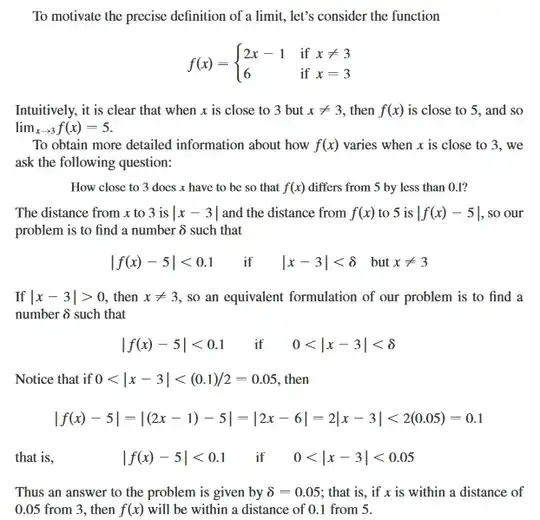There are a couple of things going on here. One is the somewhat odd challenge-response nature of the limit definition:
Eloise. The limit as $x$ approaches $3$ of $2x-1$ is $5$.
Abelard. I think it is not.
Eloise. Then you must think that there's some neighborhood of $y = 5$ that I can't force $2x-1$ into by choosing a small enough
neighborhood of $x = 3$. Otherwise, $2x-1$ is definitely approaching $5$ in the limit.
Abelard. I guess that's right.
Eloise. Well go ahead then. I challenge you to find such a neighborhood.
Abelard. Fair enough. I challenge you to find a neighborhood of $x = 3$ such that for every $x$ in that neighborhood, $2x-1$ is within
$0.1$ of $5$.
Eloise. Sure! I choose the neighborhood $(2.95, 3.05)$.
Abelard. Hmm...I'm not sure that works.
Eloise. You're not sure? Then you must think there's a value of $x$ in that neighborhood for which $2x-1$ isn't within $0.1$ of $5$. I
challenge you to come up with such an $x$.
Abelard. [thinks for a moment] I guess I can't come up with such an $x$. OK, I admit that I can't force you outside a $0.1$ margin of $5$.
But what about a margin of—
Eloise. Let me stop you right there. Whatever margin you were going to say right then, let me call it $\varepsilon$. Then let me define
$\delta = \varepsilon/2$.
Abelard. OK, I'm following.
Eloise. Well then I challenge you to come up with any value that's within $\delta$ of $x = 3$ such that $2x-1$ isn't within
$\varepsilon$ of $y = 5$.
Abelard. [thinks again for a longer while] No, I concede again that I cannot. I admit that the limit as $x$ approaches $3$ of $2x-1$ must
indeed be $5$.
It's not coincidental, by the way, that I choose Abelard and Eloise as our players in this mathematical back-and-forth (nor that I spell Eloise without her usual H). It harks back to the min-max game semantics of logic formalized by the Finnish logician Jaakko Hintikka, in which the verifier (personified by Eloise and represented by the existential quantifier $\exists$) proposes that there is a limit, a proposition that the falsifier (personified by Abelard and represented by the universal quantifier $\forall$) attempts to puncture by finding a counterexample. For more information, read the Wikipedia plot summary for independence-friendly logic.
To interpret this definition in a more conventional manner, let me state it in English, but indented, so you can see the scoping:
- No matter what $\varepsilon$-neighborhood of $y = 5$ we choose,
- there's a $\delta$-neighborhood of $x = 3$, such that
- for any value of $x$ in that $\delta$-neighborhood*,
- $2x-1$ is in that $\varepsilon$-neighborhood.
*Other than possibly $x = 3$ itself.
Let's now consider how Eloise might have arrived at her $\delta$. She appears, like Stewart, to have conjured up $\delta = \varepsilon/2$ almost out of thin air, but that's clearly not true. The key is to work backward from $\varepsilon$ toward $\delta$, and then once we get there, we show how to move forward from $\delta$ toward $\varepsilon$. Unfortunately, there is an aesthetic in much mathematical exposition that eschews showing the backward step, so the fact that the forward step works seems almost miraculous.
In fact, it's pretty straightforward, especially in this case. Remember, Eloise's goal is to force $2x-1$ into an $\varepsilon$-neighborhood of $5$, no matter what $\varepsilon$ is. So, she asks herself, how wide an interval around $x = 3$ will still yield a value of $2x-1$ in that neighborhood?
Here, we're aided by the fact that $2x-1$ is strictly increasing. (In fact, of course, it's linear, but never mind that now.) So in order for $2x-1$ not to be too high, we need
$$
2x-1 < 5+\varepsilon
$$
and for $2x-1$ not to be too low, we need
$$
2x-1 > 5-\varepsilon
$$
Adding $1$ to both sides and dividing by $2$, for both inequalities, yields
$$
x < 3+\frac{\varepsilon}{2} \\
x > 3-\frac{\varepsilon}{2}
$$
That is, we're OK as long as we don't exceed $3$ by $\varepsilon/2$ or more, and as long as we don't fall short of $3$ by $\varepsilon/2$ or more. More succinctly, as long as we're closer to $3$ than $\delta = \varepsilon/2$, we're good. And this works no matter what value of $\varepsilon$ we're challenged with, so we are done!
That's the process we go through in general, although it might be complicated by some properties of the function in question. For example, our analysis was simplified by the fact that $2x-1$ is monotonic. But if we want to show that
$$
\lim_{x \to 1} x^2 = 1
$$
we have to contend with the fact that $x^2$ isn't monotonic. If we're challenged with $\varepsilon = 2$, we have to make sure that as we decrease $x$ below $-1$, we stay above $-1$ and below $3$. That doesn't turn out to be too difficult, but we can easily conjure up examples where identifying the proper margin isn't trivial. Nevertheless, for exercises in textbooks, we can always do it.
Finally, as some other answers have pointed out, once we've identified a workable $\delta$-interval, any smaller interval will also work, because that smaller interval will always be a subset of the one we've already shown to work. In our example, if $\delta = \varepsilon/2$ works, then $\delta = \varepsilon/3$ will also work, as will $\delta = \varepsilon/4$, etc. So it's not always necessary to pick the largest possible interval; we just have to find one that works. Sometimes, we choose one that's smaller than strictly necessary, because it makes our demonstration easier. That's completely fine, so long as it's strictly positive; we can't have an interval of width $0$.
